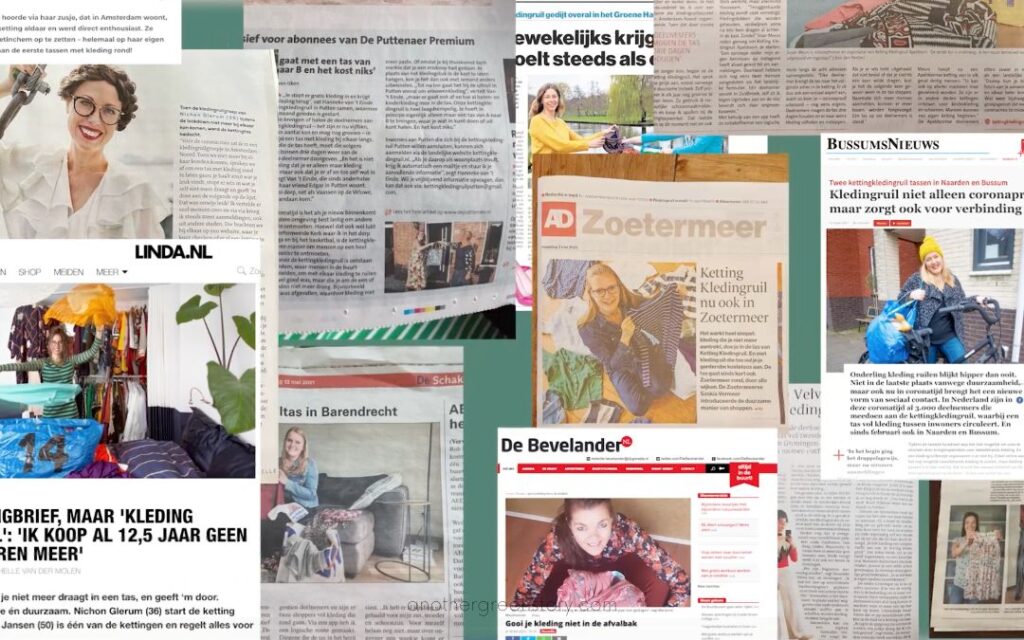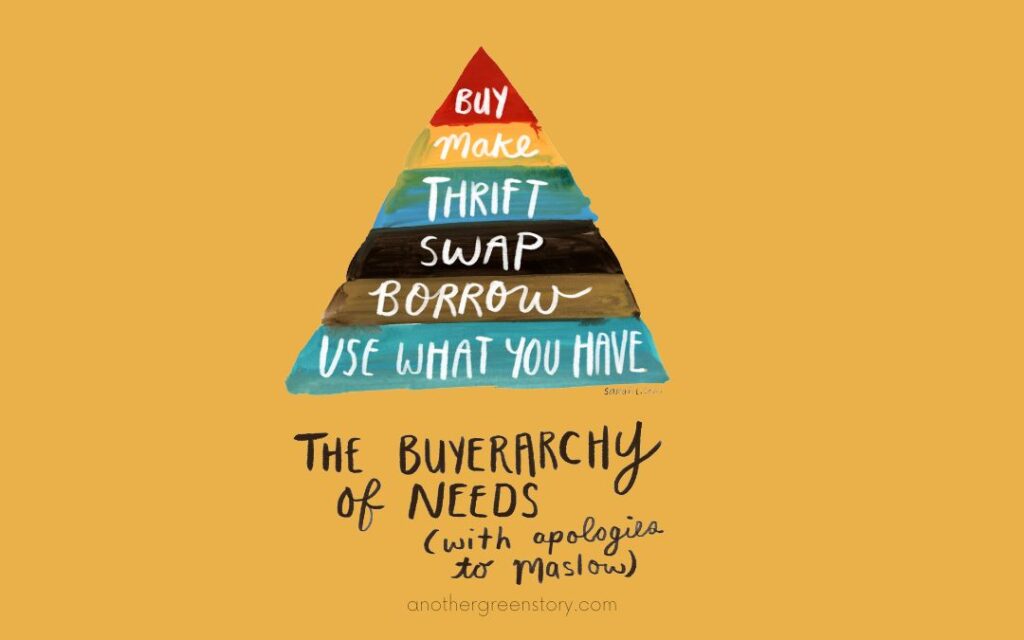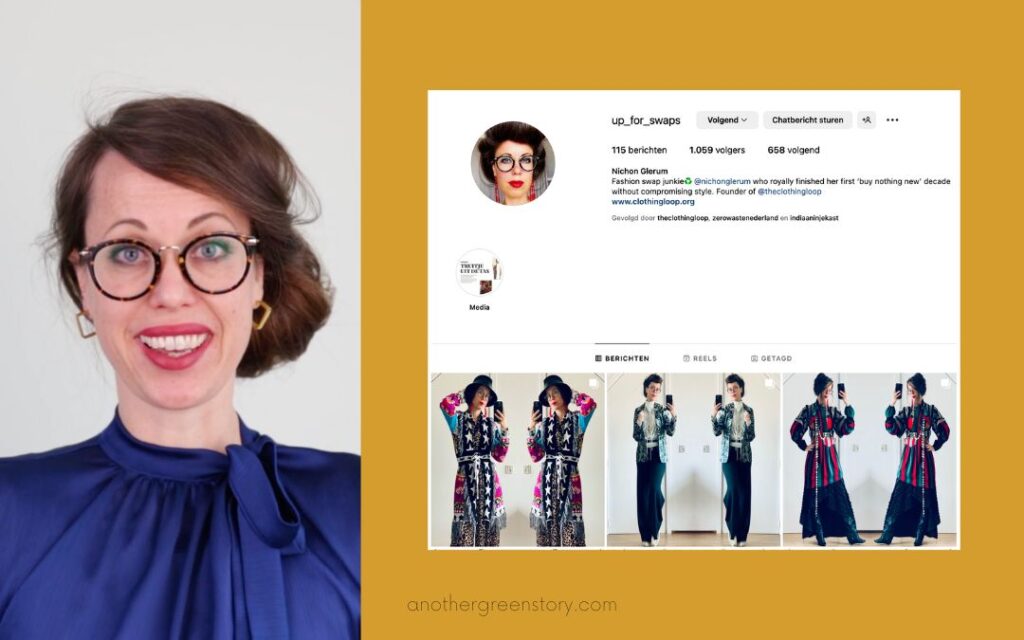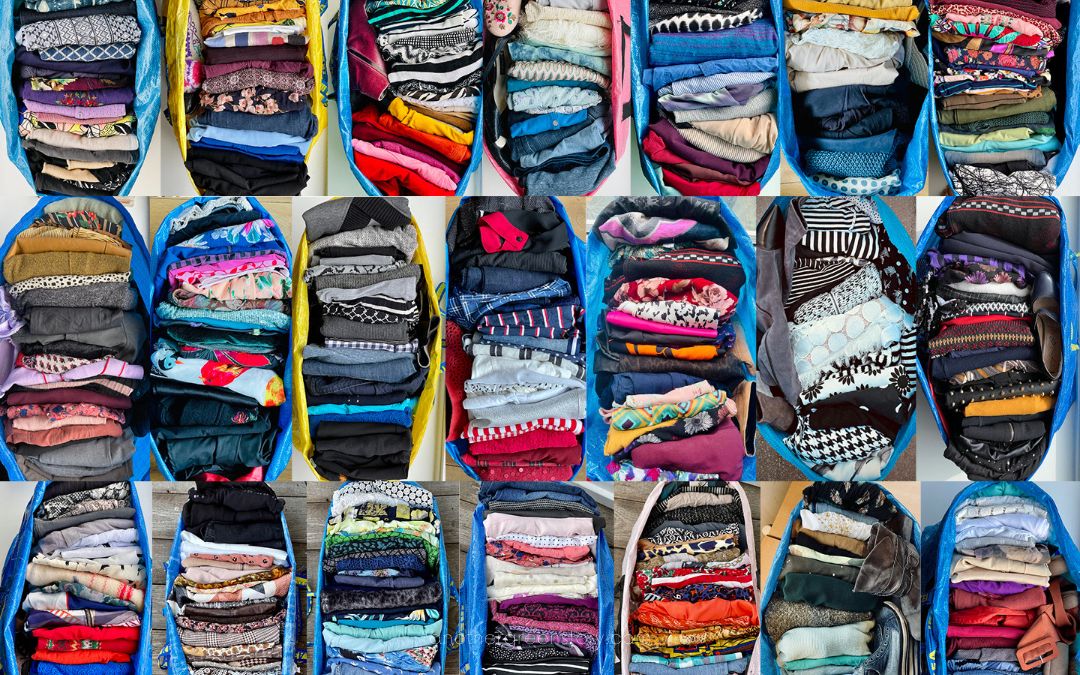In a world dominated by fast fashion and consumerism, where trends change at the speed of light, one woman dared to challenge the status quo. Meet Nichon Glerum, a talented photographer with a background in design and a passion for secondhand clothing. She accidentally builds an empire that revolutionizes the way we view fashion. Embark on a thrilling tale of community, sustainability, and empowerment, as The Clothing Loop takes shape.
Listen to the Another Green Story Podcast: Change Maker Clothing Loop
Listen & subscribe to our podcast via Soundcloud, iTunes or Spotify
From Local Swaps to Global Phenomenon
The story of the Clothing Loop began in the intimate setting of Nichon Glerum’s living room, where she hosted small-scale swap events. However, fate had other plans in store. As the world was hit by the global pandemic, people began clearing out their closets, yearning for a fresh start. The idea of sharing bags of clothing in a WhatsApp group took hold, sparking a chain of events that would transform the accidental swap empire.

With the help of a passionate producer within the community, the Clothing Loop took its first steps, guided by trial and error. Nichon Glerum and her dedicated team of volunteers discovered the secrets to success: determining the ideal bag size and the number of bags per participant. As lockdowns eased, the momentum slowed temporarily, but the second lockdown brought a renewed sense of purpose.
The Birth of a Movement
Word of mouth spread, and the Clothing Loop’s popularity surged. Nichon Glerum realized that she couldn’t single-handedly coordinate swaps across Amsterdam. To address the growing demand, she collaborated with the producer and devised a solution—a Google form that connected participants to their local loops. The movement quickly gained traction, growing from a handful of loops to an astounding 27 in the Netherlands alone.
A Tidal Wave of Change: Growing Visibility and the Snowball Effect
Fueling the fire of success, a media person within the community drafted a press release that caught the attention of the masses. Media coverage propelled the Clothing Loop into the spotlight, attracting volunteers and participants alike. Soon, there were over 70 to 80 clothing loops, hosted by passionate volunteers, springing up throughout the Netherlands and beyond.

Spreading Wings Internationally: The Clothing Loop Goes Global
The Clothing Loop’s reach transcended borders, sparking a spin-off in Switzerland and spreading to 14 countries across four continents. Remarkably, this expansion required no physical infrastructure, avoiding the logistical challenges typically associated with international ventures. Instead, the movement relied on the passion and dedication of volunteers, as well as the power of technology and community-building.
The Power of Unity: A School of Fish Making Waves
Like a school of fish navigating the vast ocean, the Clothing Loop thrived due to its collective spirit. By banding together, these loops became a force to be reckoned with, their visibility and impact impossible to ignore. With every new loop, the movement gained validation, inspiring individuals in smaller cities, villages, and even abroad to embrace the power of community and sustainability.
Beyond Business: A Movement with a Mission
The Clothing Loop is not a profit-driven enterprise; it is a force for change, driven by a deep-rooted mission. Nichon Glerum’s vision was never to turn this endeavor into a business but rather to create a movement that would reshape the way we view fashion. Working predominantly with volunteers, she emphasizes the sense of ownership and collective responsibility that permeates the Clothing Loop. It’s about empowering individuals to take action and make a tangible difference in their own lives and the world around them.
The Clothing Loop is an independent initiative within the Slow Fashion Movement.

Sustainable and social impact
Sustainability lies at the heart of the Clothing Loop movement. By promoting the reuse and repurposing of clothing, the initiative tackles the staggering environmental impact of the fashion industry. Each loop encourages participants to declutter their wardrobes, reducing textile waste and minimizing the carbon footprint associated with garment production.
Reducing your annual clothing purchases by just six items can save around 40 kilograms of CO2 emissions, equivalent to driving a gasoline car from Amsterdam to Paris. The Clothing Loop aims to gather one million swappers in the next five years, resulting in a CO2 reduction equal to circling the world 5,000 times in that car. It highlights the power of collective action and sustainable fashion choices for a positive environmental impact.
According to the impact report available on the website, approximately half of the respondents acknowledged experiencing either a minor or significant shift in their consumer behavior. This shift in mindset among nearly half of the participants is a substantial achievement.
Moreover, 90% of the remaining respondents stated that they were already embracing sustainable fashion and lifestyle practices, such as thrifting and mending, prior to engaging with our platform. In their case, the Clothing Loop served as an additional avenue to facilitate and enhance their existing practices. Only a small percentage, around 5 or 6%, viewed our platform solely as a source of free clothes. Therefore, the overwhelming majority of 95% recognized the transformative influence of our platform and affirmed that it had positively impacted their mindset.
But the Clothing Loop is not solely focused on environmental sustainability. It also fosters a sense of community and connection.
The Inner Workings of the Clothing Loop: A Sustainable & Social Cycle
The process is straightforward. You begin by joining your local loops, and the system strategically places you at a convenient location on the route. This ensures that you don’t have to travel long distances to reach the next person in line or the individual before you.

The bags of clothing primarily circulate in a clockwise direction, but there’s an occasional exception known as the “ghostwriter bag,” which travels in the opposite direction. As there are other participants ahead of you, you may encounter various styles as the bags are passed along. If you come across something you like in a bag, you are encouraged (but it’s not mandatory) to share a picture of it in the app group. By doing so, other participants may see your photo, and it can lead to interesting connections.
Direct interactions typically occur with the person before you and the person following you on the list. Sometimes, these encounters involve a friendly chat, a coffee meetup, or even blossoming friendships. Recently Nichon Glerum received a picture from two ladies in her group who attended a documentary film festival together. They became friends through the platform and shared a selfie from the cinema, proudly showcasing what they were wearing from the bags.
Even if you don’t form friendships, participating in the system can still help you feel more connected to your neighborhood. It becomes easier to recognize familiar faces and fosters a sense of belonging.
Moreover, the Clothing Loop provides a convenient space for fulfilling specific needs. Suppose you require an outfit for a wedding, a skiing trip, a themed party, or any other occasion. In that case, you can easily reach out to your group and ask if anyone has what you’re looking for. More often than not, the situation resolves itself as people lend and borrow items among each other. This aspect of the system also offers an opportunity to meet new individuals since the person immediately following you on the list may not have the specific item you need.
Break free from consumerism
Furthermore, the Clothing Loop empowers individuals to break free from the grip of consumerism. In a society where trends and disposable fashion dominate, this movement challenges the notion that we must constantly buy new clothes to be stylish. Instead, it encourages a shift in mindset towards a more conscious and mindful approach to fashion. Participants learn to appreciate the value and uniqueness of pre-loved garments, realizing that true style goes beyond the latest trends.
The vision for a sustainable (fashion) future according to Nichon Glerum
When considering the steps needed to ensure a sustainable fashion industry, Nichon Glerum refers to the hierarchy of needs. While Maslow’s hierarchy of needs is widely known, there is also the Buyerarchy of Needs by Sarah Lazarovic.

The Buyerarchy of Needs follows a sequence starting from the bottom. First, it emphasizes the importance of utilizing what you already have and making the most of it. This includes repairing and restyling existing items. The next step is borrowing or lending, followed by swapping with others. These three steps form the foundation of the hierarchy.
When the bottom three steps are executed locally, they have minimal to no impact on the environment. This means they can be practiced consistently. However, the innate human desire for something new remains, and it is in our nature to want to fulfill this need. Yet, if we can fulfill this need through the bottom three steps, it would be a significant achievement.
By encouraging and promoting the bottom three steps of the Buyerarchy of Needs on a large scale, we can make substantial progress towards sustainability in the fashion industry. This requires a collective effort to shift our behaviours and consumption patterns.
How Evil Practises from Shein and Primark may actually be a good thing
For a long time, H&M and Zara were often criticised in the fashion industry. However, we now have more brands like Shein and Primark that are regarded as having even more negative impacts. There is an article written by Emy Dekes that suggests these brands, despite their questionable practices, may inadvertently serve a positive purpose. Their actions have evoked a strong sense of discontent among people, forcing them to confront the harsh realities of the industry.
Note from the writer: The concept of evil or questionable practices leading to unintended positive consequences has been a subject of philosophical and moral discussions. Some philosophers explore the idea that certain actions, although morally objectionable, can result in transformative outcomes or awaken collective awareness about social issues.
Nichon Glerum hopes that reaching the lowest point in terms of material consumption and labor exploitation will act as a catalyst for a much-needed change in mindset.
This change is essential for us to prioritize the lower three layers of the Buyerarchy of Needs. By doing so, clothing manufacturers would be compelled to design garments that can be shared among multiple individuals. Whether someone no longer needs a piece, their body undergoes changes, or their life takes a new direction, the clothing can find a new home without compromising its quality or appeal. This is a transformation that Nichon genuinely hopes will take place because, currently, it is far from being a reality.
Change takes time
However, it is important to recognize that change takes time. Therefore, Nichon Glerum advice to others is to be patient and not overly critical of themselves. Instead of passing judgment, let us focus on inspiring one another. It is through this collective inspiration that we can make significant strides toward a sustainable fashion future.
Nichon herself is a real inspiration and living proof that one can look like royalty in 100% second hand clothes. She didn’t buy anything new for more over a decade.

In conclusion: Clothing Loop
The Clothing Loop movement led by Nichon Glerum has ignited a revolution in sustainable fashion. From humble beginnings, it has blossomed into a global phenomenon, uniting individuals around the world in their quest for a more ethical and mindful approach to dressing. Through swapping, community-building, and a shared mission, the Clothing Loop empowers individuals to make a positive impact on the planet while embracing their personal style.
As Nichon pointed out, that with the Clothing Loop it’s really giving people a valid alternative that’s not pointing fingers.

